Bosch HGS8655UC Manual

Free-standing range
Use and Care Manual
HGS8655UC, HGS8645UC

Table of Contents |
|
9 Safety Definitions ..................................................... |
3 |
IMPORTANT SAFETY INSTRUCTIONS ........................ |
4 |
Fire Safety .............................................................................. |
5 |
Gas Safety ............................................................................. |
6 |
Burn Prevention .................................................................... |
6 |
Child Safety ........................................................................... |
6 |
Cleaning Safety ..................................................................... |
7 |
Cookware Safety .................................................................. |
7 |
Proper Installation and Maintenance ................................ |
7 |
Proposition 65 Warning: ..................................................... |
7 |
Conversion to Propane Gas ............................................... |
8 |
High Altitude Installation ..................................................... |
8 |
Getting Started ............................................................... |
9 |
Parts and Accessories ........................................................ |
9 |
Burner Cap Placement ........................................................ |
9 |
Inserting Racks .................................................................. |
10 |
Accessories Included ....................................................... |
10 |
Special Accessories (not included) ............................... |
11 |
Operating the cooktop ................................................ |
11 |
Before Using the Appliance for the First Time ............ |
11 |
About the Appliance ......................................................... |
11 |
Getting the Most Out of Your Appliance ....................... |
12 |
Notes Regarding Cookware ........................................ |
15 |
Suitable Cookware ............................................................ |
15 |
Cookware Recommendations ........................................ |
15 |
Information for Use ........................................................... |
15 |
Cleaning and Maintenance-Cooktop ......................... |
16 |
Cleaning .............................................................................. |
16 |
Cleaning Guidelines ......................................................... |
16 |
Burnt-on Dirt ....................................................................... |
17 |
Operating the Oven ..................................................... |
18 |
Before Using the Appliance for the First Time ............ |
18 |
About the Appliance ......................................................... |
18 |
Getting the Most Out of Your Appliance ...................... |
20 |
Cleaning and Maintenance-Oven ............................... |
21 |
Cleaning the Oven ............................................................ |
21 |
Replacing the Door Seal ................................................. |
22 |
Cleaning Self-cleaning Surfaces .................................... |
22 |
Maintenance ....................................................................... |
22 |
Cooking Charts ........................................................... |
25 |
Baked Goods/Entrees ..................................................... |
25 |
Meats ................................................................................... |
26 |
Technical Service ........................................................ |
28 |
Before Calling for Service ............................................... |
28 |
How to Obtain Warranty Service .................................... |
29 |
STATEMENT OF LIMITED PRODUCT WARRANTY .. |
30 |
What this Warranty Covers & Who it Applies to ......... |
30 |
How Long the Warranty Lasts ........................................ |
30 |
Repair/Replace as Your Exclusive Remedy ................ |
30 |
Out of Warranty Product .................................................. |
30 |
Warranty Exclusions ......................................................... |
30 |
Obtaining Warranty Service: ........................................... |
31 |
9Safety Definitions
9WARNING
This indicates that death or serious injuries may occur as a result of non-observance of this warning.
9CAUTION
This indicates that minor or moderate injuries may occur as a result of non-observance of this warning.
NOTICE: This indicates that damage to the appliance or property may occur as a result of non-compliance with this advisory.
Note: This alerts you to important information and/or tips.
3
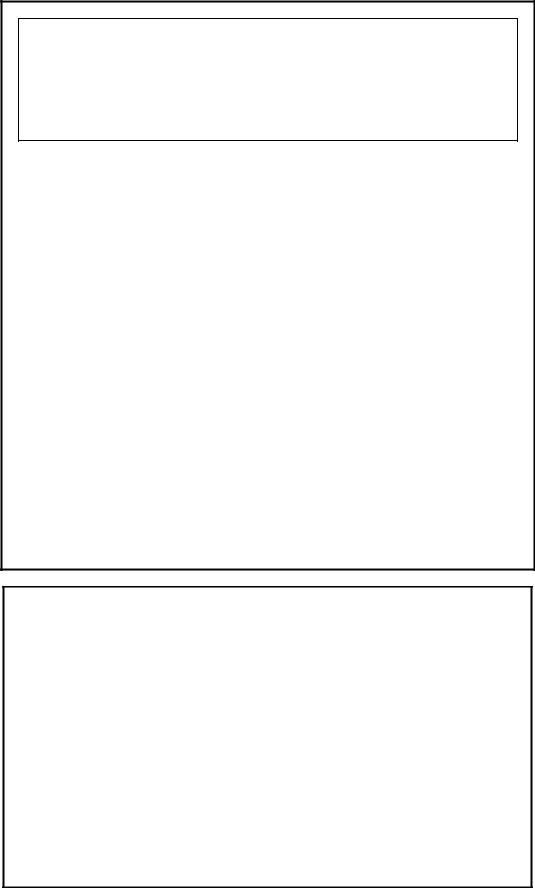
9 IMPORTANT SAFETY INSTRUCTIONS
READ AND SAVE THESE INSTRUCTIONS
:$51,1* ,I WKH LQIRUPDWLRQ LQ WKHVH LQVWUXFWLRQV LV QRW IROORZHG H[DFWO\ D ILUH RU H[SORVLRQ PD\ UHVXOW FDXVLQJ SURSHUW\ GDPDJH SHUVRQDO LQMXU\ RU GHDWK
²'R QRW VWRUH RU XVH JDVROLQH RU RWKHU IODPPDEOH YDSRUV DQG OLTXLGV LQ WKH YLFLQLW\ RI WKLV RU DQ\ RWKHU DSSOLDQFH
²:+$7 72 '2 ,) <28 60(// *$6'R QRW WU\ WR OLJKW DQ\ DSSOLDQFH'R QRW WRXFK DQ\ HOHFWULFDO VZLWFK'R QRW XVH DQ\ SKRQH LQ \RXU EXLOGLQJ
,PPHGLDWHO\ FDOO \RXU JDV VXSSOLHU IURP D QHLJKERU·V SKRQH )ROORZ WKH JDV VXSSOLHU·V LQVWUXFWLRQV,I \RX FDQQRW UHDFK \RXU JDV VXSSOLHU FDOO WKH ILUH GHSDUWPHQW
²,QVWDOODWLRQ DQG VHUYLFH PXVW EH SHUIRUPHG E\ D TXDOLILHG LQVWDOOHU VHUYLFH DJHQF\ RU WKH JDV VXSSOLHU
:$51,1*
1HYHU 2SHUDWH WKH 7RS 6XUIDFH &RRNLQJ 6HFWLRQ RI WKLV $SSOLDQFH 8QDWWHQGHG)DLOXUH WR IROORZ WKLV ZDUQLQJ VWDWHPHQW FRXOG UHVXOW LQ ILUH H[SORVLRQ RU EXUQ KD]DUG WKDW FRXOG FDXVH SURSHUW\ GDPDJH SHUVRQDO LQMXU\ RU GHDWK,I D ILUH VKRXOG RFFXU NHHS DZD\ IURP WKH DSSOLDQFH DQG LPPHGLDWHO\ FDOO \RXU ILUH GHSDUWPHQW '2 127 $77(037 72 (;7,1*8,6+ $1 2,/ *5($6( ),5( :,7+ :$7(5
4
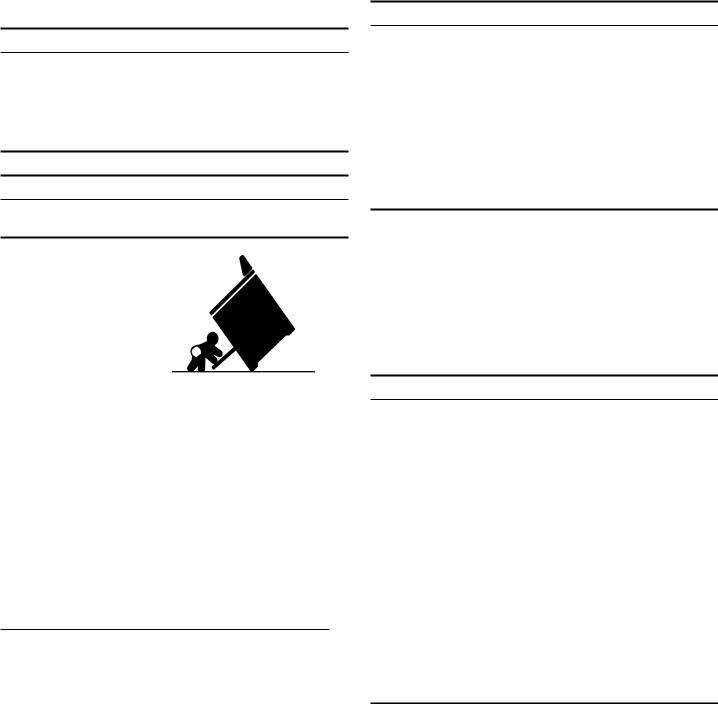
9 IMPORTANT SAFETY INSTRUCTIONS
READ AND SAVE THESE INSTRUCTIONS
IMPORTANT: SAVE THESE INSTRUCTIONS FOR THE LOCAL ELECTRICAL INSPECTOR’S USE.
INSTALLER: LEAVE THESE INSTRUCTIONS WITH THE UNIT FOR THE OWNER.
OWNER: PLEASE RETAIN THESE INSTRUCTIONS FOR FUTURE REFERENCE.
WARNING
When properly cared for, your new appliance has been designed to be safe and reliable. Read all instructions carefully before use. These precautions will reduce the risk of burns, electric shock, fire and injury to persons.
When using kitchen appliances, basic safety precautions must be followed including those in the following pages.
WARNING
TIP OVER HAZARD
A child or adult can tip the range over and be killed.
Install the anti-tip device to the structure and/or the range. Verify the anti-tip device has been properly installed and engaged.
Engage the range to the anti-tip device. Ensure the anti-tip device is reengaged when the range is moved.
Re-engage the anti-tip device if the range is moved. Do not operate the range without the anti-tip device in place and engaged.
See installation instructions for details.
Failure to follow the instructions in this manual can result in death or serious burns to children and adults.
Check for proper installation and use of the anti-tip bracket. Carefully tip the range forward pulling from the back to ensure that the anti-tip bracket engages the range leg and prevents tip-over. The range should not move more than 1” (2.5cm).
Fire Safety
Save these instructions.
Set the burner control so that the flame does not extend beyond the bottom of the pan.
Do not allow aluminum foil, plastic, paper or cloth to come in contact with a hot surface element, burner or grate. Do not allow pans to boil dry.
If the cooktop is near a window, forced air vent or fan, be certain that flammable materials such as window coverings do not blow over or near the burners or elements. They could catch on fire.
Always have a working smoke detector near the kitchen.
Never leave the cooktop unattended when in use. Boilovers cause smoking and greasy spillovers may ignite.
WARNING
TO REDUCE THE RISK OF A GREASE FIRE:
a.Never leave surface units unattended at high settings. Boilovers cause smoking and greasy spillovers that may ignite. Heat oils slowly on low or medium settings.
b.Always turn hood ON when cooking at high heat or when flambéing food (i.e. Crepes Suzette, Cherries Jubilee, Peppercorn Beef Flambé).
c.Clean ventilating fans frequently. Grease should not be allowed to accumulate on fan or filter.
d.Use proper pan size. Always use cookware appropriate for the size of the surface element.
In the event that personal clothing or hair catches fire, drop and roll immediately to extinguish flames.
Smother flames from food fires other than grease fires with baking soda. Never use water on cooking fires.
Take care that drafts like those from fans or forced air vents do not push the flames so that they extend beyond the edges of the pan.
Have an appropriate fire extinguisher available, nearby, highly visible and easily accessible near the appliance.
WARNING
TO REDUCE THE RISK OF INJURY TO PERSONS IN THE EVENT OF A GREASE FIRE, OBSERVE THE FOLLOWING:
a.SMOTHER FLAMES with a close-fitting lid, cookie sheet, or metal tray, then turn off the burner. BE CAREFUL TO PREVENT BURNS. If the flames do not go out immediately, EVACUATE AND CALL THE FIRE DEPARTMENT.
b.NEVER PICK UP A FLAMING PAN – You may be burned.
c.DO NOT USE WATER, including wet dishcloths or towels – a violent steam explosion will result.
d.Use an extinguisher ONLY if:
-You know you have a Class ABC extinguisher, and you already know how to operate it.
-The fire is small and contained in the area where it started.
-The fire department is being called.
-You can fight the fire with your back to an exit.
Whenever possible, do not operate the ventilation system during a cooktop fire. However, do not reach through fire to turn it off.
5

9 IMPORTANT SAFETY INSTRUCTIONS
READ AND SAVE THESE INSTRUCTIONS
Gas Safety
To prevent carbon monoxide build-up, do not block appliance air vents.
Have the installer show you where the gas shut-off valve is located.
For proper burner performance, keep igniters clean and dry.
If a burner goes out and gas escapes, open windows and doors. Wait until gas dissipates before using the appliance.
IMPORTANT SAFETY NOTICE: Burning gas cooking fuel generates some by-products which are on the list of substances which are known by the State of California to cause cancer or reproductive harm. To minimize exposure to these substances, always operate this unit according to the instructions contained in this booklet and provide good ventilation.
WARNING
Use this appliance only for its intended use as described in this manual. NEVER use this appliance as a space heater to heat or warm the room. Doing so may result in carbon monoxide poisoning and overheating the appliance. Never use the appliance for storage.
WARNING
NEVER cover any slots, holes or passages in the oven bottom or cover an entire rack with materials such as aluminum foil. Doing so blocks air flow through the oven and may cause carbon monoxide poisoning. Aluminum foil linings may also trap heat, causing a fire hazard.
WARNING
All igniters spark when any single burner is turned on. Do not touch any of the burners when the cooktop is in use.
If you smell gas, your installer has not done a proper job of checking for leaks. If the connections are not perfectly tight, you can have a small leak and, therefore, a faint smell. Finding a gas leak is not a “do-it-yourself” procedure. Some leaks can only be found with the burner control in the ON position and this must be done by a qualified service technician. See Warning, ~ "GasAplianceSafety" on page 4
WARNING
To prevent flare-ups all grates must be properly positioned on the cooktop whenever the cooktop is in use. Each of the feet must be placed into the corresponding dimples in the cooktop. Do not use a grate if the rubber feet are missing or damaged.
Keep the igniter ports clean for proper lighting performance of the burners. It is necessary to clean these when there is a boilover or when the burner does not light even though the electronic igniters click.
WARNING
To prevent flare-ups do not use the cooktop without all burner caps and all burner grates properly positioned.
WARNING
Do not clean or touch any of the burners when an extra low burner (if equipped) is in use. When the extra low burner automatically reignites the ignitor at the burner will spark.
Burn Prevention
DO NOT TOUCH SURFACE UNITS OR AREAS NEAR UNITS - Surface units may be hot even though they are dark in color. Areas near surface units may become hot enough to cause burns. During and after use, do not touch, or let clothing, potholders, or other flammable materials contact surface units or areas near units until they have had sufficient time to cool. Among these areas are the cooktop and areas facing the cooktop.
Do not heat or warm unopened food containers. Build-up of pressure may cause the container to burst and cause injury.
Use high heat settings on the cooktop only when necessary. To avoid bubbling and splattering, heat oil slowly, on no more than a low-medium setting. Hot oil is capable of causing extreme burns and injury.
Never move a pan of hot oil, especially a deep fat fryer. Wait until it is cool.
Secure all loose garments, etc., before beginning. Tie long hair so that it does not hang loose, and do not wear loose-fitting clothing or hanging garments, such as ties, scarves, jewelry, or dangling sleeves.
Do not place any objects on the projecting control panel in front of the burners. The area becomes very hot during cooking.
Child Safety
When children become old enough to use the appliance, it is the responsibility of the parents or legal guardians to ensure that they are instructed in safe practices by qualified persons.
Do not allow anyone to climb, stand, lean, sit, or hang on any part of an appliance, especially a door, warming drawer, or storage drawer. This can damage the appliance, and the unit may tip over, potentially causing severe injury.
Do not allow children to use this appliance unless closely supervised by an adult. Children and pets should not be left alone or unattended in the area where the appliance is in use. They should never be allowed to play in its vicinity, whether or not the appliance is in use.
6
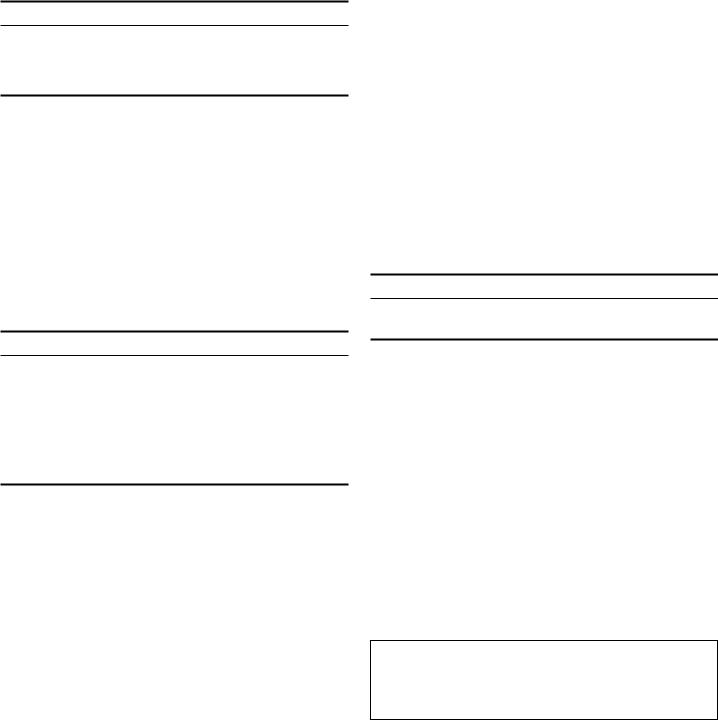
9 IMPORTANT SAFETY INSTRUCTIONS
READ AND SAVE THESE INSTRUCTIONS
CAUTION
Items of interest to children should not be stored in an appliance, in cabinets above an appliance or on the backsplash. Children climbing on an appliance to reach items could be seriously injured.
Cleaning Safety
IMPORTANT SAFETY NOTICE: The California Safe Drinking Water and Toxic Enforcement Act requires the Governor of California to publish a list of substances known to the state to cause cancer, birth defects or other reproductive harm, and requires businesses to warn customers of potential exposure to such substances. The burning of gas cooking fuel and the elimination of soil during self-cleaning can generate some by-products which are on the list. To minimize exposure to these substances, always operate this unit according to the instructions contained in this booklet and provide good ventilation.
WARNING
Burning gas cooking fuel may create small amounts of carbon monoxide, benzene and formaldehyde. To minimize exposure to these substances, the burners should be adjusted by a certified installer or agency to ensure proper combustion. Ensure proper ventilation with an open window or use a ventilation fan or hood when cooking with gas. Always operate the appliance according to the instructions in this manual.
After a spill or boilover, turn off the burner and allow the cooktop to cool. Clean around the burner and burner ports. After cleaning, check for proper operation.
Do not clean the appliance while it is still hot. Some cleaners produce noxious fumes when applied to a hot surface. Wet clothes and sponges can cause burns from steam.
Cookware Safety
Hold the handle of the pan when stirring or turning food. This helps prevent spills and movement of the pan.
Use Proper Pan Size.
The use of undersized cookware will expose a portion of the heating element or burner to direct contact and may result in ignition of clothing. Select cookware having flat bottoms large enough to cover the surface heating unit. This appliance is equipped with one or more surface units of different sizes. Proper relationship of cookware to heating element or burner will also improve efficiency.
Always position handles of utensils inward so they do not extend over adjacent work areas, burners, or the edge of the cooktop. This reduces the risk of fires, spills and burns.
Adjust burner flame size so that it does not extend beyond the edge of the cookware. Proper relationship of cookware to burner flame reduces safety risks.
Proper Installation and Maintenance
Have the installer show you the location of the circuit breaker or fuse. Mark it for easy reference.
This appliance must be properly installed and grounded by a qualified technician. Connect only to properly grounded outlet. Refer to Installation Instructions for details.
This appliance is intended for normal family household use only. It is not approved for outdoor use. See the Statement of Limited Product Warranty. If you have any questions, contact the manufacturer.
Do not store or use corrosive chemicals, vapors, flammables or nonfood products in or near this appliance. It is specifically designed for use when heating or cooking food. The use of corrosive chemicals in heating or cleaning will damage the appliance and could result in injury.
WARNING
Failure to operate knobs properly may result in personal injury and damage to the appliance.
This appliance is not intended for operation with an external time switch or external remote control.
Do not operate this appliance if it is not working properly, or if it has been damaged. Contact an authorized service provider.
Do not repair or replace any part of the appliance unless specifically recommended in this manual. Refer all servicing to a factory authorized service provider.
To avoid electrical shock hazard, before servicing the appliance, switch power off at the service panel and lock the panel to prevent the power from being switched on accidentally.
Proposition 65 Warning:
This product may contain a chemical known to the State of California, which can cause cancer or reproductive harm. Therefore, the packaging of your product may bear the following label as required by California:
67$7( 2) &$/,)251,$ 352326,7,21 :$51,1*
:$51,1*
&DQFHU DQG 5HSURGXFWLYH +DUP ZZZ3 :DUQLQJV FD JRY
7

9 IMPORTANT SAFETY INSTRUCTIONS
READ AND SAVE THESE INSTRUCTIONS
Conversion to Propane Gas
WARNING
Personal injury or death from electrical shock may occur if the appliance is not installed by a qualified installer or electrician.
Any additions, changes or conversions required in order for this appliance to satisfactorily meet the application needs must be made by a qualified technician.
High Altitude Installation
This appliance has been tested for operation up to an altitude of 10,000 ft (3,048 m) elevation above sea level.
If desired, for altitudes above 2,000 ft (610 m) elevation above sea level, adjustments may be made. Burners should be checked at the lowest setting, if the flame is not stable the simmer should be increased until the flame is stable. This can be done by adjusting the bypass screw in the valve. If flame performance is satisfactory, adjustment will not be required. It is required that a Certified Professional make the high altitude adjustments during installation.
8
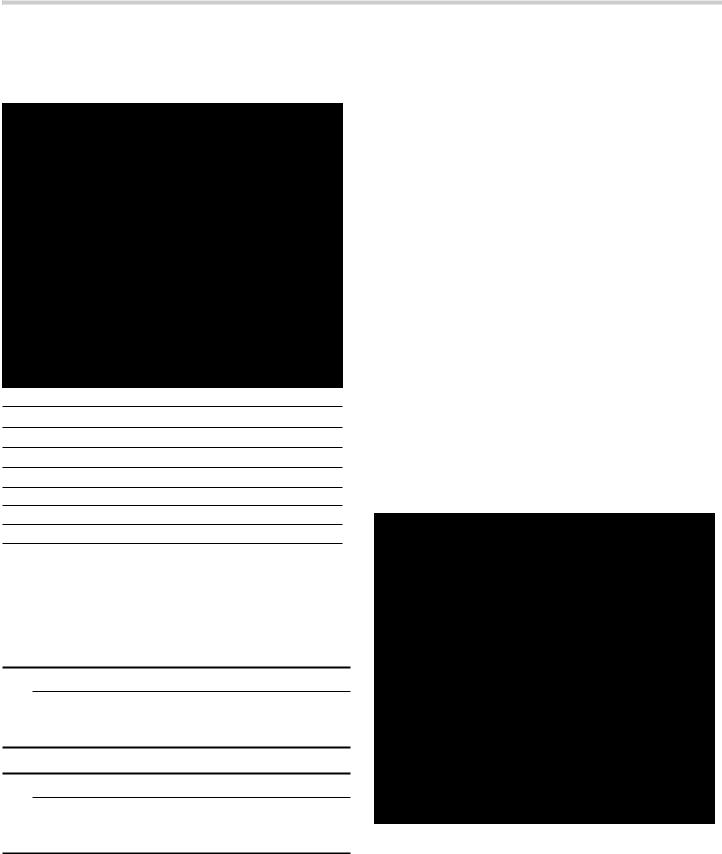
Getting Started
Parts and Accessories
36”
No. Designation
( Dual-flame burner (18,000 BTU/ 5.3 kW) 0 Small burner (5,000 BTU/ 1.5 kW)
8Large burner (10,000 BTU/ 2.9 kW) Bake burner (17,000 BTU/ 5.0 kW) Broiler, 30” range (11,500 BTU/ 3.4 kW) Broiler, 36” range (14,000 BTU/ 4.1 kW)
Burner Cap Placement
Sealed burners
Your new cooktop has sealed gas burners. There are no burner parts under the cooktop to clean, disassemble or adjust. Your cooktop has three different burner sizes: small, large and dual-flame.
9WARNING
To prevent flare-ups, do not use the cooktop without all burner caps and all burner grates properly positioned.
9WARNING
To prevent burns, do not touch burner caps orgrates while hot. Turn the cooktop off and allow the burners to cool.
The burner parts must be correctly positioned for the cooktop to function properly. If the burner parts are not correctly positioned, one or more of the following problems may occur:
Burner flames are too high.
Flames shoot out of burners.
Burners do not ignite.
Burner flames light unevenly.
Burner emits gas odor.
Burner Cap and Burner Base Placement
After electrical connection is complete, place each burner base on the corresponding location on the cooktop. One of the three bars on the burner base should line up with the notch and prevent the base from rotating. The small hole or cutout near the edge should also line up with the igniter. Pay special attention to avoid damaging the igniter during installation of the base. See Illustration below.
Once each base is located and resting evenly, place each burner cap on its correct burner base. See Illustration.
Place burner cap gently on top of base so that the prongs of the burner base fit snugly into the groove of the burner cap.
If the maintop is removed by a certified installer (for example to check electrical or piping connection) the panhead screws that were removed must be re-installed to ensure proper functionality of burners.
9
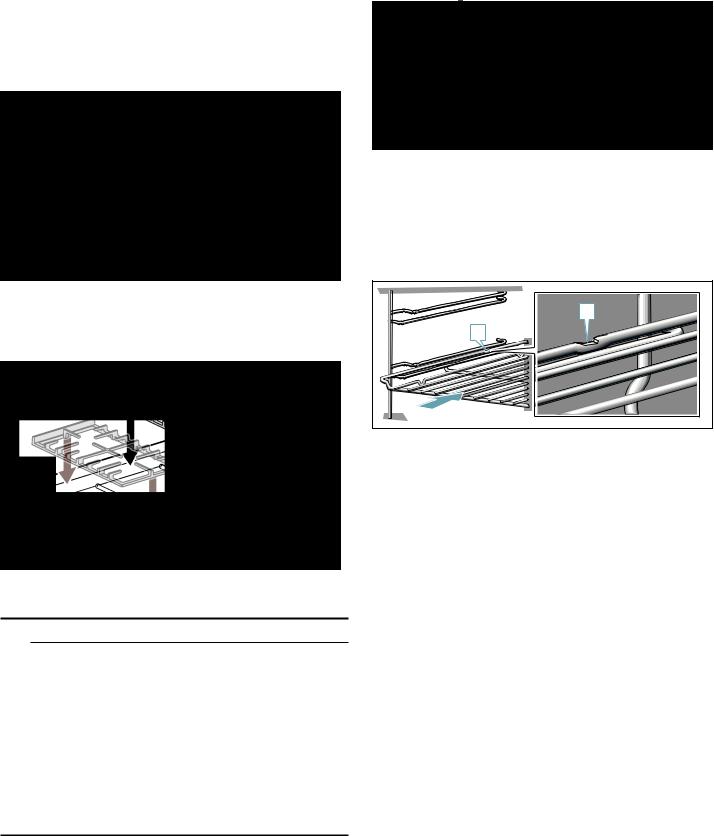
Checking Burner Cap Placement
Check to make sure that there is no gap between the burner cap and burner base. See illustration below for correct and incorrect placements of the burner cap.
You may gently try to move the burner cap from side to side to check if it is properly placed. If properly placed, the cap will click from side to side as the prongs hit the groove ridge.
Install Grates
First position the outer grates, followed by the the central grate. If you only have two grates, the order in which you position them is not relevant.
Inserting Racks
9CAUTION
To avoid burns, place oven racks in desired positions before turning oven on. Always use oven mitts when the oven is warm. If a rack must be moved while the oven is hot, do not let oven mitts contact hot heating elements.
Use caution when removing oven racks from the lowest rack position to avoid contact with the hot oven door.
To avoid possible injury or damage to the appliance, ensure racks are installed exactly per installation instructions and not backwards or upside down.
The wire rack can be inserted into the cooking compartment at five different levels. Always push accessories in fully so that they do not touch the door
panel. Make sure that you always insert the accessories into the cooking compartment the right way round.
Flat Rack
The rack is designed with a stop so it will stop before coming completely out of the oven and not tilt.
To insert wire rack into oven:
1.Grasp rack firmly on both sides.
2.Insert rack (see picture).
D |
D |
3.Tilt rack up to allow stop into rack guide.
4.Bring rack to a horizontal position and push the rest of the way in.
Rack should be straight and flat, not crooked.
To remove Flat Rack from Oven:
1.Grasp rack firmly on both sides and pull rack toward you.
2.When the stop is reached, tilt rack up and pull the rest of the way out.
Accessories Included
Your appliance is equipped with the following accessories:
Wire rack |
Use: |
|
Inserting cake pans, baking dishes, |
|
cookware, meat and frozen meals. |
|
36” order number: 11034062 |
|
|
Telescopic |
Use: |
rail |
Pulling wire rack out further without tip- |
|
ping. |
|
Order number: 12029918 |
|
|
10
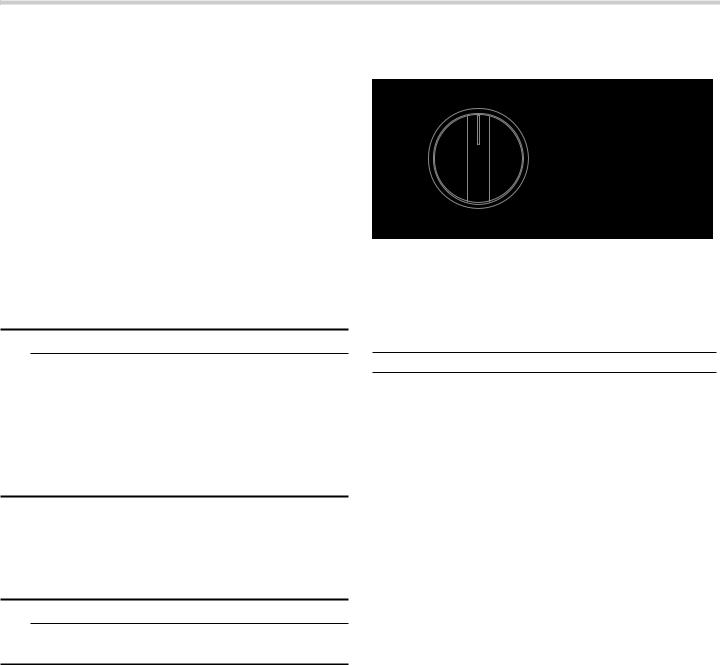
Special Accessories (not included)
Wok ring |
Use: |
|
Only suitable for dual-flame burners. |
|
Use cookware with a rounded bottom. |
|
Order number: HEZ9GW23UC |
Griddle plate |
Use: |
|
The griddle plate with non-stick coating |
|
allows meals that are usually cooked in |
|
a pan to be prepared with reduced fat. |
|
Order number: HEZ9GR41UC |
|
|
Side panel |
Use: |
|
Side cover for appliances without adja- |
|
cent kitchen units. |
|
|
Backguard |
Use: |
|
Cover for the wall behind the cooktop. |
|
|
Operating the cooktop
Before Using the Appliance for the First Time
Remove all packing materials and literature from the cooktop surface.
Wipe with a clean, damp sponge and dry.
There may be a slight odor during the first several uses. This is normal and will disappear.
Optimum cooking results depend on the proper cookware being selected and used. See “Choosing Cookware - Cookware Recommendations”.
Read all safety precautions and Use and Care Manual information prior to operating.
About the Appliance
Use the cooktop for surface cooking applications such as boiling, frying, simmering, steaming and sautéing.
9WARNING
The burning of gas cooking fuel can create small amounts of carbon monoxide, benzene, formaldehyde and soot. To minimize exposure to these substances, the burners should be adjusted by a certified installer or authorized servicer to ensure proper combustion. Ensure proper ventilation with an open window or use a ventilation fan or hood when cooking with gas. Always operate the unit according to the instructions in this manual.
Control Knobs
The cooktop has one control knob for each burner. Push in and turn to the left to light and set the desired heat setting.
9WARNING
Failure to operate knobs properly may result in personal injury and damage to the appliance.
The cooktop has standard burner controls.
Symbol |
Meaning |
off |
Cooking zone switched off |
|
|
min |
Minimum power |
max |
Maximum power |
|
|
o |
Inner flame switched on |
ðInner and outer flame switched on
To operate
Select the appropriate control knob, push in and turn counterclockwise to the desired flame size. Turn off by turning the control knob clockwise to off.
In Case of Power Failure
In the event of a power failure, the burners may be lit with a match. Press the control knob for the selected burner and turn it counterclockwise to the highest power setting. Carefully hold a lit lighter or match against the burner.
Flame Failure Safety System
Your rangetop is equipped with a safety system that cuts off the gas when the burners are accidently turned off. To ensure that this device is active: Turn on the burner as usual. Without releasing the control knob, press and hold it in firmly for 4 seconds after lighting the flame.
11
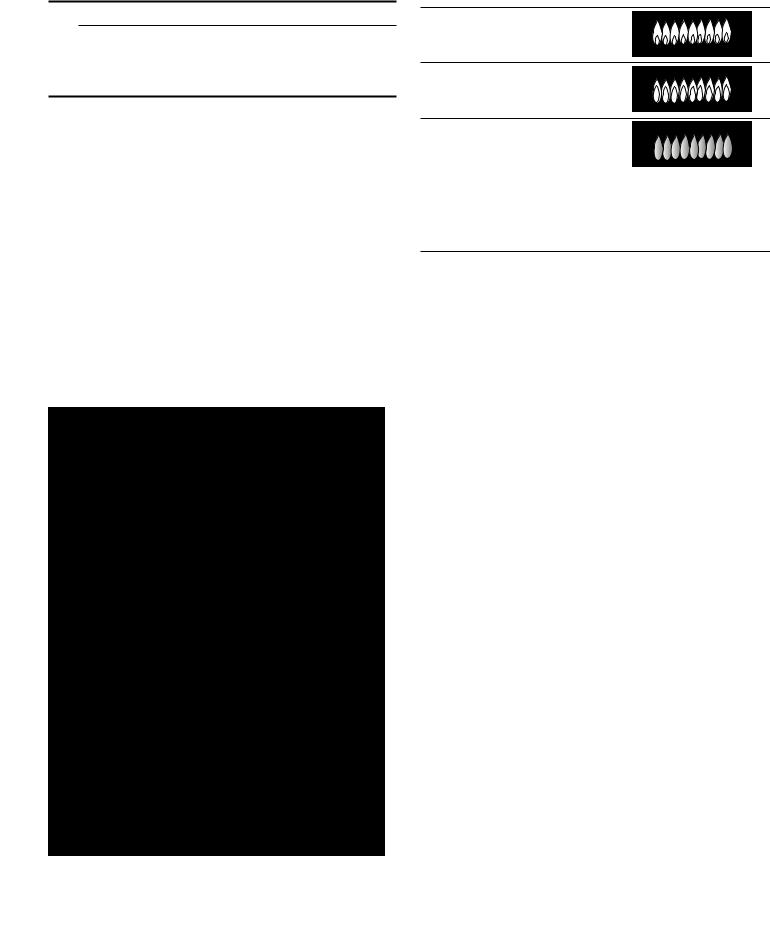
Normal Operation - Electronic Ignition
The cooktop uses electronic igniters to light the burners. There is no pilot light. Each burner has its own igniter. All igniters are activated when a control knob is pushed.
9CAUTION
To avoid possible injury or damage to the appliance, ensure grates are installed exactly per installation instructions and not backwards or upside down.
The igniter should be clean and dry for proper operation.
Avoid getting water or food on the igniter.
If the igniter is wet or soiled, it may spark without igniting the burner, or even spark continuously when a flame is present.
Note: If the burner does not light within 4 seconds, turn the burner off. Check to see that the burner cap is positioned correctly on the burner base and the igniter is clean and dry. Wait at least 5 minutes before igniting the burner again. If a burner still fails to ignite, see “Before Calling for Service”.
When a flame is present and a Low setting is used, the igniter may occasionally spark. This is normal.
Griddle plate
The griddle plate allows meals that are usually cooked in a pan to be prepared with reduced fat.
Installing the griddle plate
Typical flame characteristics
The burner flame should be blue in color and stable with no yellow tips, excessive noise or fluttering. It should burn completely around the burner cap.
Checking the flame characteristics:
Yellow flames:
Further adjustment is required.
Yellow tips on outer cones:
Normal for propane gas.
Soft blue flames:
Normal for natural gas.
Orange flames:
Can be normal if certain types of humidifiers are used in the home. Flames should return to blue without the humidifier running.
If the flame is completely or mostly yellow, verify that the regulator is set for the correct fuel. Retest after adjustment.
Some yellow streaking is normal during the initial startup. Allow the appliance to operate for 4–5 minutes and reevaluate before making adjustments.
Foreign particles in the gas line may cause an orange flame during initial use. This should disappear with use. Check the burner to make sure that port holes are not obstructed. If the ports are clogged ~ Page 28
Note: An audible "pop" may be heard when the burner is turned off manually. The "popping" may be louder with propane gas than with natural gas. This is normal.
Getting the Most Out of Your Appliance
Cooking suggestions for best results
Boil water in covered pot on High using largest burner for best results. If water boils over, turn to a lower setting.
When melting chocolate or butter, use smallest burner with a water bath for best results.
When simmering, bring food to a boil first. Stir well to be sure all the food is boiling, then cover and reduce the flame to the desired setting to simmer.
There should be steam and slight quivering of the liquid’s surface while simmering.
Use a lid to keep a more constant cooking temperature and heat food faster.
Check the food occasionally to see if the control knob should be turned to a lower or higher setting.
It is normal to stir food occasionally.
Center the pan over the burner before turning the burner on.
Use proper cookware.
Refer to the settings recommendations in the following chart for suggested settings.
12
Settings recommendations |
|
Uses |
Heat setting |
|
|
Boiling (i.e. water, stock, etc.) |
High |
|
|
Pan frying, sautéing, browning meat, |
Medium High |
deep frying |
|
Shallow frying, eggs, pancakes, |
Medium |
bacon |
|
Standard Burner Cooking
The table lists the optimal heating setting for various dishes. The temperature and cooking time depend on the amount, composition and temperature of the food. Setting ranges are indicated for this reason. Try using the lower values at first. During cooking heat may be increased.
Steaming, braising |
Medium Low |
|
|
||
Melting chocolate, melting butter, simLow |
|
|
|
||
mering sauces, soups and stews (i.e. |
|
|
|
||
tomato sauce, alfredo sauce, beef |
|
|
|
||
stew, etc.) |
|
|
|
|
|
|
|
|
|
|
|
Standard Burner Cooking Table |
|
|
|
|
|
|
|
Heat Level |
Heat Level |
||
Food |
Burner |
Start Cooking |
Continue Cooking |
||
|
|
(boil, melt, brown. fry, etc.) |
(simmer, braise, poach, hold, etc.) |
||
|
|
|
|
|
|
Beverages |
|
|
|
|
|
Mulled Cider |
Dual Flame |
High |
Medium Low |
||
Large |
|||||
|
|
|
|
||
|
|
|
|
|
|
Hot Chocolate |
Dual Flame |
Medium High |
Low |
||
Large |
|||||
|
|
|
|
||
|
|
|
|
||
Tea |
Small |
High |
Low |
||
Breads |
|
|
|
|
|
French toast |
Dual Flame |
Medium |
Medium-Medium Low |
||
Large |
|||||
|
|
|
|
||
|
|
|
|
|
|
Pancakes |
Dual Flame |
Medium |
Medium-Medium Low |
||
Large |
|||||
|
|
|
|
||
|
|
|
|
|
|
Grilled Sandwiches |
Dual Flame |
Medium |
Medium-Medium Low |
||
Large |
|||||
|
|
|
|
||
|
|
|
|
|
|
Cereals |
|
|
|
|
|
Beans |
Dual Flame |
High |
Medium-Medium Low |
||
Large |
|||||
|
|
|
|
||
|
|
|
|
||
Cornmeal/Polenta |
Large |
High |
Medium-Medium Low |
||
|
|
|
|
||
Grits |
Large |
High |
Medium-Medium Low |
||
Oatmeal |
Large |
High |
Medium-Medium Low |
||
|
|
|
|
|
|
Deep Frying |
|
|
|
|
|
French Fries |
Dual Flame |
Medium High |
Medium High |
||
Donuts |
Dual Flame |
Medium High |
Medium High |
||
Desserts |
|
|
|
|
|
Pie Filling, Fruit Compote |
Small |
Medium Low |
Medium-Medium Low |
||
|
|
|
|
||
Pudding |
Small |
Medium Low |
Medium-Medium Low |
||
Poached Fruit |
Dual Flame |
High-Medium High |
Medium-Medium Low |
||
Large |
|||||
|
|
|
|
||
|
|
|
|
|
|
Eggs |
|
|
|
|
|
Fried |
Dual Flame |
Medium High |
Medium Low |
||
Large |
|||||
|
|
|
|
||
|
|
|
|
|
|
Scrambled |
Dual Flame |
Medium High |
Medium Low-Low |
||
Large |
|||||
|
|
|
|
||
|
|
|
|
|
|
Meat, Fish, Poultry |
|
|
|
|
|
Bacon, Sausage Patties |
Dual Flame |
Medium High |
Medium-Medium Low |
||
Braising: Swiss Steak, Pot |
Dual Flame |
Medium High |
Low |
||
Roast, Stew Meat |
|||||
|
|
|
|
||
13
Heat Level |
Heat Level |
Start Cooking |
Continue Cooking |
(boil, melt, brown. fry, etc.) |
(simmer, braise, poach, hold, etc.) |
|
|
Medium |
Medium-Medium Low |
|
|
Medium High |
Medium |
|
|
High |
Medium Low |
|
|
|
|
High |
High |
|
|
|
|
High |
Low |
High |
Low |
|
|
|
|
High |
Low |
|
|
Medium |
Low |
|
|
Medium |
Low |
|
|
|
|
Medium |
Low |
|
|
High |
Low |
|
|
High |
Low |
|
|
|
|
High |
Medium |
|
|
High |
Medium |
|
|
14
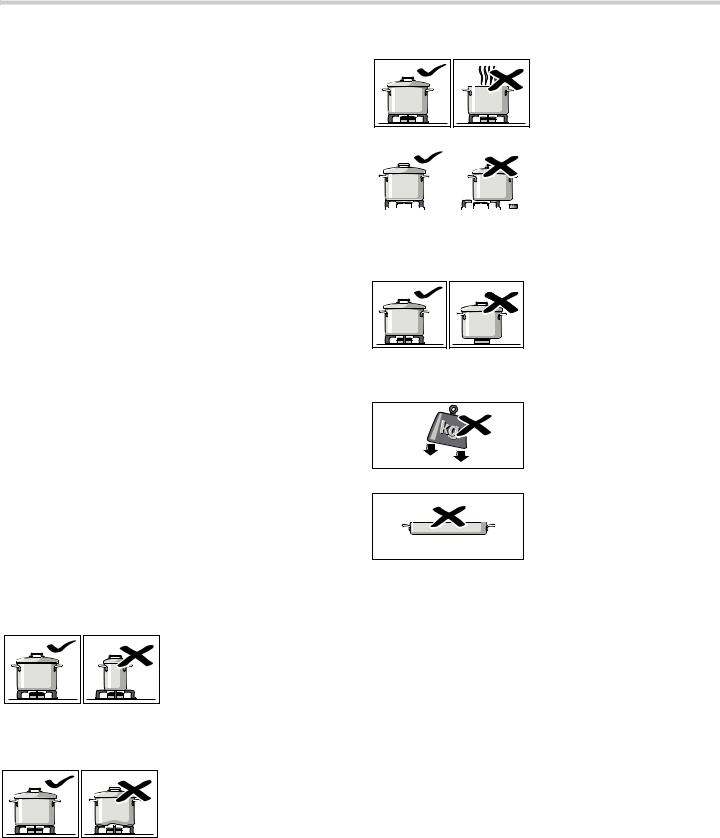
Notes Regarding Cookware
The following information and tips have been provided to help you save energy and avoid damaging your cookware.
Suitable Cookware
Burner |
Recommended pan base diameter |
|
|
|
|
|
|
|
|
|
|
|
|
|
|
|
|
|
|
Small burner |
5” - 8” (127 - 203 mm) |
|
|
|
|
|
|
|
|
|
|
|
|
|
|
|
|
|
|
|
|
|
|
|
|
|
|
|
|
|
|
|
|
|
|
|
|
|
|
Large burner |
7” - 91/2” (178 - 240 mm) |
|
|
|
|
|
|
|
|
|
|
|
|
|
|
|
|
|
|
Dual-flame |
7” - 11“ (178 - 280 mm) |
|
|
|
|
|
|
|
|
|
|
|
|
|
|
|
|
|
|
|
|
|
|
|
|
|
|
|
|
|
|
|
|
|
|
|
|
||
burner |
|
|
|
|
|
|
|
|
|
|
|
|
|
|
|
|
|
|
|
|
|
|
|
|
|
|
|
|
|
|
|
|
|
|
|
|
|
|
|
Pans with a diameter of less than 4.7” (120 mm) or
more than 11.0” (280 mm) should not be used. If you do use larger pans, these should not protrude beyond the edges of the appliance.
Cookware Recommendations
Note: When using certain pots or pans, a slight and temporary deformation of the steel cooking surface may occur. This is normal and does not affect the functionality of the appliance.
Proper Cookware
Aluminum or copper bottomed pans conduct heat evenly.
Steel pan, if not combined with other metals, may cook unevenly.
Cast-iron cookware absorbs heat slowly and cooks more evenly at low-to-medium settings.
Flat heavy bottoms pans provide even heat and stability.
DO NOT USE pans that are thin, warped, dented or ridged as they heat unevenly.
Information for Use
Use cooking vessels of appropriate size for the
particular burner.
Don't use small cooking vessels on large burners.
The flame shouldn't come in contact with the sides of the cooking vessel.
Don't use any deformed cooking vessels that don't
stand solidly on the cooktop. The vessels could
tip over.
Only use cooking vessels with flat and thick bottoms.
Don't cook without a lid or if the lid is not on all the way. The majority of the heat is lost.
Place the cooking vessel in the center of the burner, otherwise it may tip over.
Don't place large pots on the burners near the stove controls. They could overheat and become damaged.
Place the pots on the pan supports, never directly onto the burners.
Prior to use, ensure that the pan supports and lids of the gas burners are positioned correctly.
Handle vessels carefully on the cooktop.
Don't bang the cooktop and don't place any heavy weights on it.
Never heat a cooking vessel (e.g. roasting tin, pan, cooking stone) with multiple burners, except of the griddle plate. The resulting accumulation of heat causes damage to the appliance.
15

Cleaning and Maintenance-Cooktop
Cleaning
The entire cooktop can be safely cleaned by wiping with a soapy sponge, then rinsing and drying. If stubborn soil remains, follow the recommended cleaning methods below.
Cleaning recommendations:
Always keep the appliance area clear and free from combustible materials, gasoline, and other flammable vapors and liquids.
Always use the mildest cleaner that will do the job. Use clean, soft cloths, sponges or paper towels.
Rub stainless steel finishes in the direction of the grain. Wipe area dry to avoid water marks.
Before cleaning, be certain the burners are turned off and the grates and burners are cool.
Do not clean removable cooktop parts in any self cleaning oven or dishwasher.
Do not obstruct air flow around cooktop burners, range backguard and door area.
After cleaning, place all parts in their proper positions before using cooktop.
For proper burner performance, keep igniters clean and dry.
Keep the igniter ports clean for proper lighting performance of the burners. It is necessary to clean these when there is a boilover or when the burner does not light even though the electronic igniters click.
Do not use flammable cleansers such as lighter fluid.
Do not use chlorine based cleaners.
Always test cleaners on a small inconspicuous area first.
9CAUTION
All igniters spark when any single burner is turned on. Do not touch any of the burners when the cooktop is in use.
Cleaning Guidelines
The cleaners recommended below and on the following page indicate a type and do not constitute an endorsement of a particular brand. Use all products according to package directions.
Cooktop part / material |
Suggested cleaners |
Important reminders |
||
|
|
|
|
|
Burner base / |
|
Detergent and hot water; rinse and |
|
Do not scratch or gouge the port |
aluminum alloy |
|
dry thoroughly. |
|
openings. |
|
|
Stiff nylon bristle tooth brush to clean |
|
Clean ports with a wire or straight- |
|
|
port openings. |
|
ened paper clip. |
|
|
Abrasive cleansers: Brillo® or S.O.S.® |
|
Do not use a toothpick that may break |
|
|
pads. Rinse and dry. |
|
off. |
|
|
|
|
Do not soak burner bases. |
|
|
|
|
|
Burner cap / porcelain enamel |
|
Detergent and hot water; rinse and |
|
Acidic and sugar-laden spills deterio- |
|
|
dry thoroughly. |
|
rate the porcelain enamel. |
|
|
Nonabrasive Cleansers: Omit ammo- |
|
Remove soil immediately after unit |
|
|
nia, Fantastic®, Formula 409®. |
|
has cooled enough to touch. |
|
|
Mild Abrasive Cleansers: Bon Ami®, |
|
Do not use wet sponge or towel on |
|
|
Ajax®, Comet®. |
|
hot porcelain. |
|
|
Liquid cleaners: Bar Keeper's Friend®, |
|
Do not soak burner caps. |
|
|
Soft Scrub®. |
|
Always apply minimal pressure with |
|
|
|
||
|
Bar Keeper's Friend Soft Cleanser Liq- |
|
abrasive cleaners. |
|
|
|
uid®. |
|
Dry thoroughly after cleaning. |
|
|
Reassemble. Make sure that the cap |
||
|
|
|
|
|
|
|
is seated on the base. |
|
|
|
|
|
|
|
Control knobs and bezels |
|
Detergent and hot water; rinse and |
|
Do not soak knobs. |
|
|
dry thoroughly. |
|
Do not use abrasive scrubbers or |
|
|
|
||
|
|
To remove knobs, pull outward. |
|
cleansers, such as Bon Ami®, Ajax®, |
|
|
|
|
or Comet®. They may permanently |
|
|
|
|
damage the finish or remove graph- |
|
|
|
|
ics. |
16
Cooktop part / material |
Suggested cleaners |
Important reminders |
|
|
|
|
|
Exterior finish / stainless steel |
Nonabrasive Cleaners: Hot water and |
|
Do not use steel wool pads. They will |
|
detergent, Fantastic®, Formula 409®. |
|
scratch the surface. |
|
Rinse and dry immediately. |
|
Stainless steel resists most food |
|
|
||
|
Bosch Stainless Steel Conditioner |
|
stains and pit marks providing the sur- |
|
(Order number: 00576696) |
|
face is kept clean and protected. |
|
Cleaner Polish: Stainless Steel Magic® |
Never allow food stains or salt to |
|
|
to protect the finish from staining and |
|
remain on stainless steel for any |
|
pitting; enhances appearance. |
|
length of time. |
Hard water spots: Household white vinegar.
Mild Abrasive Cleaners: Bon Ami®.
Heat discoloration: Bar Keepers Friend®
Rub lightly in the direction of the grain.
Chlorine or chlorine compounds in some cleaners are corrosive to stainless steel. Check ingredients on label before using.
Grates and grate bridge / |
|
Nonabrasive cleaners: Hot water and |
|
The grates are heavy; use care when |
porcelain enamel on cast iron |
|
detergent, Fantastic®, Formula 409®. |
|
lifting. Place on a protected surface |
|
|
Rinse and dry immediately. |
|
for cleaning. |
|
|
Mild abrasive cleaners: Bon Ami® and |
|
Blisters/ crazing/ chips are common |
|
|
Soft Scrub®. |
|
due to the extreme temperatures on |
|
Abrasive cleaners for stubborn stains: |
|
grate fingers and rapid temperature |
|
|
|
changes. |
||
|
|
soap-filled steel wool pad. |
|
|
|
|
|
Acidic and sugar-laden spills deterio- |
|
|
|
You may also clean the burner grates |
|
|
|
|
in the dishwasher. Remove any burnt- |
|
rate the enamel. Remove soil immedi- |
|
|
|
ately after unit has cooled enough to |
|
|
|
on food prior to placing the burner |
|
|
|
|
|
touch. |
|
|
|
grates in the dishwasher. Place them |
|
|
|
|
|
Abrasive cleaners, used too vigor- |
|
|
|
on the lowest rack of dishwasher and |
|
|
|
|
use the dishwasher manufacturer's |
|
ously or too often can eventually mar |
|
|
recommended detergent. |
|
the enamel. |
|
|
|
|
Do not clean in a self-cleaning oven. |
|
|
|
|
|
Igniters / ceramic |
|
Carefully wipe with a cotton swab |
|
Avoid excess water on the igniter. A |
|
|
dampened with water or Formula |
|
damp igniter will prevent burner from |
|
|
409®. |
|
lighting. |
|
|
Gently scrape soil off with a toothpick. |
Remove any lint that may remain after |
|
|
|
|
|
cleaning. |
Burnt-on Dirt
For hard-to-remove, burnt-on dirt, you can order a cleaning gel from our online shop, from your specialist retailer or our Customer Service (item
number 00311859). It is suitable for pan supports and the stainless steel recess. If necessary, let the dirt soak overnight. Follow the instructions on the cleaning agent.
NOTICE: DAMAGE TO THE SURFACE -
Do not use the cleaning gel on the burner parts.
17

Operating the Oven
Before Using the Appliance for the First Time
There may be a slight odor during the first several uses. This is normal and will disappear.
Read all safety precautions and Use and Care Manual information prior to operating.
Setting the time
Once the appliance is connected to a power supply, ‚ƒ:‹‹ flashes on the display. Set the time.
1.Use the u or w button to set the time.
2.Press the v button.
Note: Once the period allowed for setting the time on the clock has elapsed, the time will automatically be saved.
The time has now been set.
Prepping the oven
1.Remove the accessories and the rack guides from the cooking compartment.
2.Completely remove any leftover packaging, e.g. small pieces of polystyrene, from the cooking compartment.
3.Remove protection film from parts.
4.Clean the outside of the appliance with a soft, damp cloth.
5.Clean the oven cavity with hot soapy water.
Initial start up
In order to prevent excess smoke and odor from manufacturing oils, heat up the oven for the first time when it is empty and closed.
Note: Make sure that there is no leftover packaging, such as polystyrene pellets, in the oven cavity. Before heating the appliance, wipe the smooth surfaces in the oven cavity with a soft, damp cloth. Keep the kitchen ventilated while the appliance is heating.
1.Operate the cooktop burners to ensure they all light and air is out the gas system. Follow instructions
~ Page 11
2.Turn off the cooktop burners.
3.Operate the oven by firmly pushing in the oven temperature control knob and holding for two seconds.
The cooling fan will come on and the sparking will be heard.
4.Turn the knob counter-clockwise to bake 500°F and release.
The oven will begin to heat and the ignition sparking will stop after a few seconds.
5.After about one hour, turn the oven temperature control clockwise to off.
6.Push in and turn the oven temperature control knob clockwise to Broil and release
7.After about 10 minutes, turn the knob clockwise to off.
8.Once oven has cooled wipe out with hot soapy water and replace rack guides.
Note: When the appliance is heating up for the first time, you may hear crackling noises coming from the oven.
Cleaning the accessories
Before using the accessories, clean them thoroughly using a cloth and warm soapy water.
Fitting the telescopic rack set
Instructions on fitting the telescopic rack set are enclosed with the set.
About the Appliance
Oven control panel
Buttons
u Oven light / minus
vTime functions
wConvection fan / plus
Note: You only need to press lightly on the buttons to operate them.
Display
: Convection fan on Q Kitchen timer AM/PM Time
18
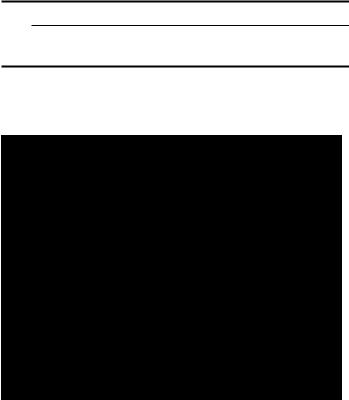
Control knobs
9WARNING
Failure to operate knobs properly may result in personal injury and damage to the appliance.
Oven
Set the temperature for the bake burner or the broiler using the control knob for the oven.
Symbol |
Meaning |
|
|
off |
Oven switched off |
250-500 |
Oven baking temperature |
|
|
broil |
Switching on the gas broiler |
|
|
To operate: Push the oven temperature control knob in firmly, hold for a few seconds, then turn to desired bake temperature or broil. Turn off by turning the control knob clockwise to off.
Notes
The oven has a push and turn feature to limit gas flow if the control is not pressed firmly in for a few seconds at the start. This is normal. Once the oven is warm, the control can be turned on and off rapidly and it will operate.
Broil has only one setting, at the positon marked broil.
Do not try to turn the oven control knob from broil to bake temperatures clockwise, or from bake temperatures to broil counter-clockwise. The control needs to go to off then change to bake or broil.
Time-setting Options
Setting the electronic clock
To set the clock the oven must be switched off.
1.Press and hold the v button until : flashes.
2.Change the time using the u and w buttons.
3.Press v button.
Setting the short-term timer
The short-term timer has no effect on how the oven operates. The duration of the short-term timer can be set from 30 seconds to 23 hours and 59 minutes.
1.Press the v button.
The v symbol flashes and the display shows ‹‹:‹‹.
2.Use the u and w buttons to set the desired time for the timer.
An audible signal sounds once the time has elapsed.
Notes
To change the remaining time, press the v button. Then use the u and w buttons to change the remaining time.
To cancel the short-term timer, press the v button. Then set the remaining time to zero using the u and w buttons.
Switching off the signal tone
Press any button to switch off the audible signal.
Note: After 7 minutes, the audible signal will stop automatically.
Changing the signal tone
Three different signal tones are available.
1.Press and hold the u and w buttons at the same time for approximately two seconds.
2.Press the v button.
The signal tone that is currently selected is shown in the display, e.g. "Tone 1".
3.Press the u button to select a different signal tone.
4.Press the v button.
Oven Features
Cooling Fan
The cooling fan runs during all cooking modes. The fan can be heard when it is running, and warm air may be felt as it is released from the oven vent. The fan may run until the oven has cooled down.
Convection Fan
The convection fan is not available for broiling. You can turn on and off the convection fan by pressing w. If the oven door is opened, the convection fan will turn off.
Oven light
Your appliance is equipped with an oven light. You can turn the oven light on and off by pressing u.
Surfaces in the oven cavity
The back wall and side parts in the oven cavity are selfcleaning. You can tell this from the rough surface.
The oven cavity floor and ceiling are enameled and have smooth surfaces.
Notes
Use an oven tray on the first bottom shelf to collect liquids produced by broiling.
Use an oven tray to bake food that could release fats or oils, in order to avoid spillage of these substances on the floor plate of the oven.
19
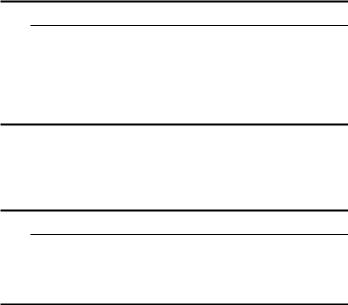
Self-cleaning surfaces
The self-cleaning surfaces are coated with a porous, matte ceramic layer. This coating absorbs and dispels splashes from baking and roasting while the appliance is in operation.
9CAUTION
Do not use oven cleaner on the self-cleaning surfaces. These will damage the surfaces. If oven cleaner does get onto these surfaces, dab it off immediately using water and a sponge cloth. Do not rub the surface and do not use abrasive cleaning aids.
Getting the Most Out of Your Appliance
Aluminum Foil
9WARNING
Do not use aluminum foil or protective liners to line any part of the appliance, especially the oven bottom. Installing these liners may result in risk of electric shock or fire.
Preheating the oven
Place oven racks in the required position before heating the oven.
Always preheat the oven.
Allow the oven to preheat while preparing recipe ingredients or food items.
Increasing the oven temperature will require a longer preheat time.
When the oven has preheated a beep indicator will sound for 2 seconds.
Once the oven is preheated, place the food in the oven as quickly as possible to minimize the loss of heat and reduction of oven temperature.
Baking Pans and Dishes
Glass baking dishes absorb heat. Some cookware manufacturers recommend reducing the temperature by 25°F when using this type of dish. Follow the manufacturers’ recommendations.
Cookie sheets should have at least 1" clearance on all sides.
Use pans that provide the desired level of browning. For tender, light, golden brown crusts, use light, anodized or shiny metal bakeware.
Dark, rough or dull pans (nonstick or anodized) will absorb heat and result in a browner, crisper crust. Some manufacturers recommend reducing the temperature by 25°F when using this type of pan. Follow the manufacturers’ recommendations.
Insulated cookie sheets or bakeware may increase the length of cooking time.
Do not place broil pans or any other heavy objects down on the open oven door.
Do not store empty pans or pizza stones in the oven during cooking as this changes the cooking performance. Store pans outside of the oven.
Opening the oven door
Open and close the appliance door only by holding the door handle. To avoid risk of burns, do not touch any other parts of the door.
Open the door as briefly as possible to avoid temperature reduction.
Use the interior oven light to view the food through the oven window rather than opening the door frequently.
High Altitude Baking
When cooking at high altitudes, recipes and cooking times will vary.
For accurate information, write the Extension Service, Colorado State University, Fort Collins, Colorado 80521. There may be a cost for the guides. Specify which high altitude food preparation guide you prefer: general information, cakes, cookies, breads, etc.
Condensation
It is normal for certain amount of moisture to evaporate from the food during any cooking process. The amount depends on the moisture content of the food. The moisture may condense on any surface cooler than the inside of the oven, such as the control panel.
Broil
Broil uses intense heat radiated from the upper element.
Broil mode is best suited for cooking thin, tender cuts of meat (1" or less), poultry and fish. It can also be used to brown breads and casseroles. Always broil with the door closed.
The benefits of broiling include:
Fast and efficient cooking.
Cooking without the addition of fats or liquids.
Tips
Preheat oven for 3–4 minutes. Do not preheat for more than 5 minutes.
Steaks and chops should be at least 3/4" thick.
Brush fish and poultry with butter or oil to prevent sticking.
Use broiler pan with grid when broiling.
Do not cover the broil grid with foil. It is designed to drain fats and oils away from the cooking surface to prevent smoking and spattering.
Turn meats (other than fish) once during the recommended cooking time. Fish does not need to be turned.
When browning the top of casseroles, use only metal or glass ceramic dishes.
Never use heat-proof glass; it cannot tolerate the high temperature.
20

Cleaning and Maintenance-Oven
To avoid electrical shock hazard, before servicing the appliance, switch power off at the service panel and lock the panel to prevent the power from being switched on accidentally.
Cleaning the Oven
Avoid These Cleaners
Do not use commercial oven cleaners such as Easy Off®. They may damage the oven finish or parts.
Chlorine or chlorine compounds in some cleansers are corrosive to stainless steel. Check ingredients on label.
Never use scouring pads or abrasive cleaners.
Oven cleaning guide
Part |
Recommendations |
|
|
Flat rack |
Clean with soapy water. Rinse |
|
thoroughly and dry, or gently rub |
|
with cleansing powder or soap- |
|
filled pads as directed. |
Telescopic rail |
Clean with soapy water. Rinse |
|
thoroughly and dry, or gently rub |
|
with cleansing powder or soap- |
|
filled pads as directed. Avoid get- |
|
ting cleansing powder in the tele- |
|
scopic slides. Re-lubrication may |
|
become necessary. Use only |
|
high-temperature food-grade |
|
lubricants to re-lubricate slides. |
Fiberglass gasket |
Do not clean the door gasket – |
|
The door gasket is essential for a |
|
good seal. Care should be taken |
|
not to rub, damage or move the |
|
gasket. |
|
|
Glass |
Clean with soapy water or glass |
|
cleaner. Apply Fantastik® or For- |
|
mula 409® to a clean sponge or |
|
paper towel and wipe clean. |
|
Avoid using powder cleaning |
|
agents, steel wool pads and |
|
oven cleaners. |
Painted surfaces |
Clean with soapy water or apply |
|
Fantastik® or Formula 409® to a |
|
clean sponge or paper towel and |
|
wipe clean. Avoid using powder |
|
cleaning agents, steel wool pads |
|
and oven cleaners. |
Part |
Recommendations |
|
|
Porcelain surfaces |
Immediately wipe up acid spills |
|
like fruit juice, milk and tomatoes |
|
with a dry cloth when surface is |
|
cool enough to touch. Do not use |
|
a moistened sponge/cloth on hot |
|
porcelain. When cool, clean with |
|
soapy water or apply Bon-Ami® |
|
or Soft Scrub® to a damp |
|
sponge. Rinse and dry. For stub- |
|
born stains, use soap-filled pads. |
|
It is normal for porcelain to show |
|
fine lines with age due to expo- |
|
sure to heat and food soil. |
Stainless steel surfaces
(HGS8.55UC,
HDS8.55.)
Never allow food stains or salt to remain on stainless steel for any length of time. Always wipe or rub in the direction of the grain. Clean with a soapy sponge, then rinse and dry, or wipe with Fantastik® or Formula 409® sprayed onto a paper towel. Protect and polish with Stainless Steel Magic® and a soft cloth. Remove water spots with a cloth dampened with white vinegar. Use Bar Keeper´s Friend® to remove heat discoloration. Chlorine or chlorine compounds in some cleansers are corrosive to stainless steel. Check the ingredients on the label.
Black stainless sur- |
For black stainless steel and anti- |
faces |
fingerprint surfaces, use a soft, |
(HGS8.45UC, |
dry towel. For stubborn dirt, use |
HDS8.45.) |
warm water diluted with a non- |
|
abrasive, mild cleansing soap. |
|
Never use stainless steel polish. |
Plastic & controls |
When cool, clean with soapy |
|
water, rinse and dry. |
|
|
Probe |
Wipe with soapy water. Do not |
(HDS8..5.) |
submerge. Do not wash in the |
|
dishwasher. |
Printed areas (words |
Do not use abrasive cleaners or |
& numbers) |
petroleum based solvents. |
|
|
21
